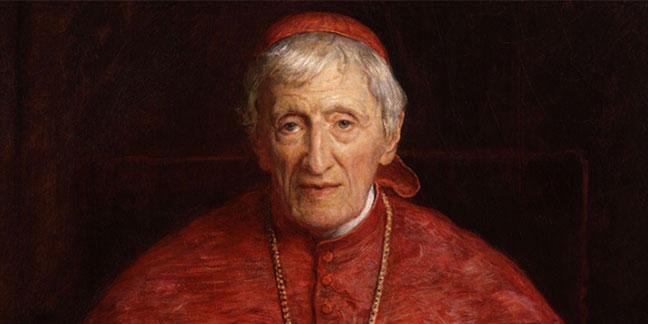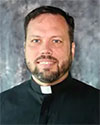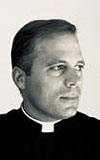 Portrait of St. John Henry Newman by Sir John Everett MillaisWhether in opera, cantatas or oratorios, it is rare that a libretto – a text of a large vocal composition – is penned by a venerated saint in the English language.
Portrait of St. John Henry Newman by Sir John Everett MillaisWhether in opera, cantatas or oratorios, it is rare that a libretto – a text of a large vocal composition – is penned by a venerated saint in the English language.
However, this is the case for British composer Edward Elgar’s “The Dream of Gerontius,” set to St. John Henry Newman’s poem of the same name.
“The Dream of Gerontius” came to my mind quite accidentally recently after I heard the news of the death of Pope Emeritus Benedict XVI, and I thought it would be worth sharing with readers of the Catholic News Herald. Listening to this work in its entirety was comforting as I prayed and thought about the late former pope. Elgar’s music and St. John Henry Newman’s words can provide hope and solace as we continue to mourn for the late former pope.
Elgar (1857-1934) was raised a Catholic. His mother converted to Catholicism five years before his birth at St. George’s Catholic Church in Worcester, where his father served as organist.
“The Dream of Gerontius” premiered in 1900 at the Birmingham Festival. Its numerous references to Catholic doctrine and emphasis on purgatory, was not well-received initially in Protestant England. The fact that the choirmaster had died days before the premiere and had to be replaced quickly also contributed to its poor reception. Regardless, it stands today as one of Elgar’s finest works.
The libretto is condensed from Newman’s original poem and is separated into two parts. Part I features the elderly man Gerontius (solo tenor) nearing death surrounded by a priest (bass solo) and companions (presented as choral sections). The text flows seamlessly between English, Latin, and even Greek for a brief Kyrie. While there are momentary sections of terror and fear, the overall mood is one of calmness, and the final words sung by Gerontius before his death are pleas to Jesus, Mary, and eventually St. Joseph, patron saint of the dying.
In Part II, the recently departed soul is accompanied by his guardian angel (solo mezzo soprano) journeying to the throne of God. In “The Judgment Now is Near,” the angel introduces the Angel of the Agony (solo bass), the angel who comforted Jesus in the Garden of Gethsemane before His Passion. According to the libretto, it is he that “best can plead with Him for all tormented souls, the dying, and the dead.” The movement ends with the Angel of Agony’s petition to Christ to spare the souls He loves so much. The composition ends with Gerontius’s guardian angel delivering his soul to purgatory, and singing that prayers and Masses said for him will be of great assistance. The souls in purgatory and an angelic choir accompany her as she bids farewell to Gerontius temporarily, for eventually, he will be in heaven.
— Christina L. Reitz, Ph.D., Special to the Catholic News Herald
More online
Listen to the final movement of “The Dream of Gerontius,” which includes English lyrics penned by St. John Henry Newman
 CHARLOTTE — Two priests who are also brothers have combined their preaching talents to write a series of books reflecting on the Scriptures, starting with the readings we will hear at Mass during Advent. The first book in the series, “All Things New: Volume 1, Advent,” was just released in time for Advent.
CHARLOTTE — Two priests who are also brothers have combined their preaching talents to write a series of books reflecting on the Scriptures, starting with the readings we will hear at Mass during Advent. The first book in the series, “All Things New: Volume 1, Advent,” was just released in time for Advent.
The series was penned by Father Michael Mitchell and Father Jason Mitchell. Father Michael serves as parochial vicar at St. Gabriel Church in Charlotte, and his brother serves in the Diocese of Erie, Pa.
The brothers – who grew up the first and second of 10 children – were ordained together in 2011. Soon the idea was hatched for a series of books reflecting on the Scriptures, using their different approaches and style of homilies.
Recalls Father Michael, “Father Jason and I were in the habit of often discussing together our Sunday homilies. We would help each other with ideas and get ready for the coming Sunday.”
Over time, the brothers noticed that they approached the Scriptures differently, based on the four primary ways of interpreting Scripture (what’s known as “hermeneutics”). Father Jason’s homilies focus on looking at the Scriptures literally and allegorically, whereas Father Michael’s homilies focus on interpreting the
Scriptures from the moral and anagogical (mystical or spiritual) viewpoints. The complementarity of their approaches inspired the brothers to collaborate.
Designed to enrich readers spiritually for years to come, “All Things New” will cover the entire three-year cycle of readings used at Masses. Each book gives the reader the daily Mass readings and four 5-minute reflections for the various seasons in the liturgical year: Advent, Christmas, Lent, Easter and Ordinary Time.
“This is a great daily prayer support for anyone who likes to do a morning meditation on Scripture,” said Father Michael. “It was awesome to write together.”
“The series will run until we complete the lectionary,” he noted. “At our current rate, we should be done in about five years with the project. Volume II on the Christmas season is set to publish next summer.”
The brothers said they hope the first book is a great aid to all, including pastors during the busy Advent season.
 Father Jason Mitchell“It does a good job of helping the reader to get a glimpse of the depth and mystery of the Holy Bible,” Father Michael said. “Father Jason and I
Father Jason Mitchell“It does a good job of helping the reader to get a glimpse of the depth and mystery of the Holy Bible,” Father Michael said. “Father Jason and I  Father Michael Mitchellboth feel that preaching during the Catholic Mass should be a sacred moment to reveal the Scriptures to the faithful. A homily should start from the Bible text and not so much from the personal anecdotes of the clergyman.
Father Michael Mitchellboth feel that preaching during the Catholic Mass should be a sacred moment to reveal the Scriptures to the faithful. A homily should start from the Bible text and not so much from the personal anecdotes of the clergyman.
The Biblical story can then be used to enlighten our life today and to hear what God is saying to us that very Sunday.”
He added, “We hope this will be a refreshing take on Scripture that will allow a person to understand the Advent season, especially how the prophets of the Old Testament prophesied about the coming of the Messiah.”
— Annie Ferguson
Order your copy today
“All Things New: Volume 1 Advent,” published by Spirit of Wisdom Press, is available at Catholic book shops and Amazon.com. For more information, go to www.spiritofwisdompress.com.

